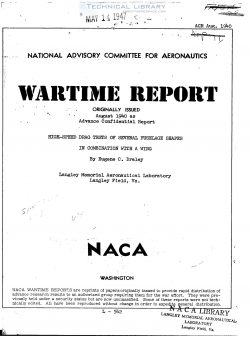naca-wr-l-542
- Version
- 105 Downloads
- 864.16 KB File Size
- 1 File Count
- April 26, 2017 Create Date
- April 26, 2017 Last Updated
National Advisory Committee for Aeronautics, Wartime Report - High Speed Drag Tests of Several Fuselage Shapes in Combination with a Wing

Drag tests were made in the S-foot high-speed wind
tunnel of 23 conditions combining six streamline shapes
and three conventional cowling-fueelage bodies. All the
models were tested in combination.with a winG in order 150
include wing-fuselage interference effects. The data were
obtained at speeds up to 440 miles per hour. corresponding
to a Mach number of 0.60 and to a Reynolds number. based
on a representative fuselage length (60 in.). of 17,400,000.
Tests were made with both normal and fixed transition: the
fixed transition is considered to represent the true drag
characteristics at full-scale flight conditions better than
normal transition.
The results from the tests of the combinations with
three streamline bodies gave effective fuselage-drag coef-
ficients from 0.046 to 0.057 at speeds from 260 to 440
miles per hour. The relative drag of two of these bodies.
differing only in fineness ratio. was considerably chanfied
by compressibility effects at high speeds. Relatively
blunt noses on streamline bodies in conjunction with the
wing produced little or no changes in either the drag or
the compressibility effects. A cooling-air intake opening
in the blunt nose caused about 7-percent increase in the
drag with no significant changes in the compressibility
effects. The best radial-engine cowling-fuselage combina-
tions had. without cooling air. drags 18 to 21 percent
greater than the corresponding streamline fuselages. de-
pending on the speed and the body.
The critical speeds of the combinations tested were.
in general. determined by the wing-fuselage Juncture. Gal-
culations indicate that material gains in critical speed
would be obtained for the streamline bodies with a wing
having a lower peak local velocity than that of the test.
Though a considerable amount of aerodynamic data for
fuselage shapes is already available. most of these data
are of limited value because of the low Reynolds numbers
and particularly of the low lach numbers of the tests.
Present and prospective speeds of aircraft demonstrate-the
need for data applicable at high speeds where compressibil-
ity effects are important.
| File | Action |
|---|---|
| naca-wr-l-542 High Speed Drag Tests of Several Fuselage Shapes in Combination with a Wing.pdf | Download |
Comment On This Post